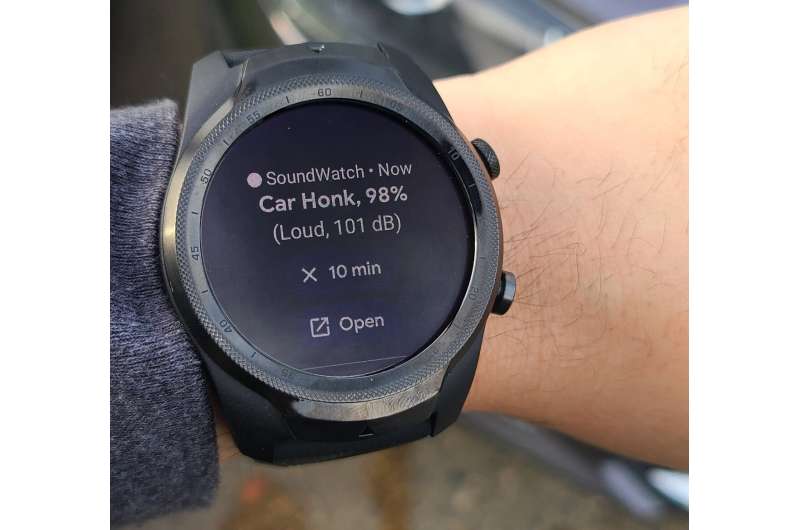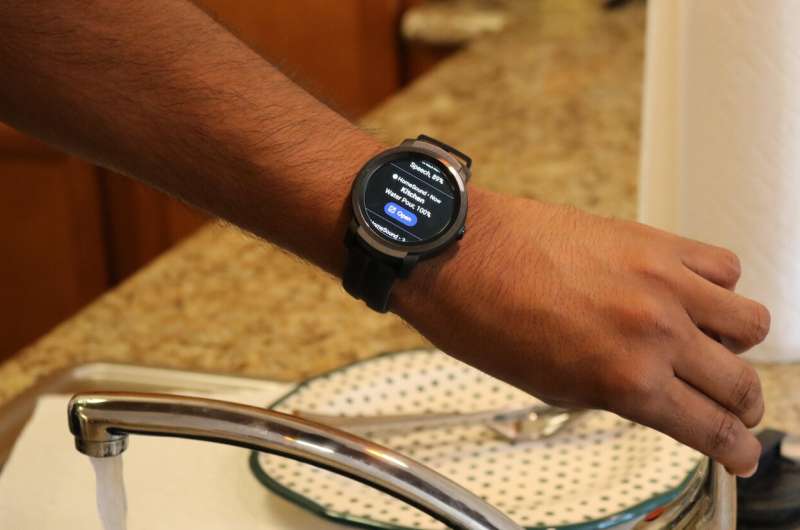SoundWatch: New smartwatch app alerts d/Deaf and hard-of-hearing users to birdsong, sirens and other desired sounds

Smartwatches offer people a private method for getting notifications about their surroundings—such as a phone call, health alerts or an upcoming package delivery.
Now University of Washington researchers have developed SoundWatch, a smartwatch app for deaf, Deaf and hard-of-hearing people who want to be aware of nearby sounds. When the smartwatch picks up a sound the user is interested in—examples include a siren, a microwave beeping or a bird chirping—SoundWatch will identify it and send the user a friendly buzz along with information about the sound.
The team presented these findings Oct. 28 at the ACM conference on computing and accessibility.
"This technology provides people with a way to experience sounds that require an action—such as getting food from the microwave when it beeps. But these devices can also enhance people's experiences and help them feel more connected to the world," said lead author Dhruv Jain, a UW doctoral student in the Paul G. Allen School of Computer Science & Engineering. "I use the watch prototype to notice birds chirping and waterfall sounds when I am hiking. It makes me feel present in nature. My hope is that other d/Deaf and hard-of-hearing people who are interested in sounds will also find SoundWatch helpful."
The team started this project by designing a system for d/Deaf and hard-of-hearing people who wanted to be able to know what was going on around their homes.
"I used to sleep through the fire alarm," said Jain, who was born hard of hearing.
The first system, called HomeSound, uses Microsoft Surface tablets scattered throughout the home which act like a network of interconnected displays. Each display provides a basic floor plan of the house and alerts a user to a sound and its source. The displays also show the sound's waveforms, to help users identify the sound, and store a history of all the sounds a user might have missed when they were not home.
The researchers tested HomeSound in the Seattle-area homes of six d/Deaf or hard-of-hearing participants for three weeks. Participants were instructed to go about their lives as normal and complete weekly surveys.
Based on feedback, a second prototype used machine learning to classify sounds in real time. The researchers created a dataset of over 31 hours of 19 common home-related sounds—such as a dog bark or a cat meow, a baby crying and a door knock.
"People mentioned being able to train their pets when they noticed dog barking sounds from another room or realizing they didn't have to wait by the door when they were expecting someone to come over," Jain said. "HomeSound enabled all these new types of interactions people could have in their homes. But many people wanted information throughout the day, when they were out in their cars or going for walks."

The researchers then pivoted to a smartwatch system, which allows users to get sound alerts wherever they are, even in places they might not have their phones, such as at the gym.
Because smartwatches have limited storage and processing abilities, the team needed a system that didn't eat the watch's battery and was also fast and accurate. First the researchers compared a compressed version of the HomeSound classifier against three other available sound classifiers. The HomeSound variant was the most accurate, but also the slowest.
To speed up the system, the team has the watch send the sound to a device with more processing power—the user's phone—for classification. Having a phone classify sounds and send the results back to the watch not only saves time but also maintains the user's privacy because sounds are only transferred between the user's own devices.
The researchers tested the SoundWatch app in March 2020—before Washington's stay-at-home order—with eight d/Deaf and hard-of-hearing participants in the Seattle area. Users tested the app at three different locations on or around the UW campus: in a grad student office, in a building lounge and at a bus stop.
People found the app was useful for letting them know if there was something that they should pay attention to. For example: that they had left the faucet running or that a car was honking. On the other hand, it sometimes misclassified sounds (labeling a car driving by as running water) or was slow to notify users (one user was surprised by a person entering the room way before the watch sent a notification about a door opening).
The team is also developing HoloSound, which uses augmented reality to provide real-time captions and other sound information through HoloLens glasses.
"We want to harness the emergence of state-of-the-art machine learning technology to make systems that enhance the lives of people in a variety of communities," said senior author Jon Froehlich, an associate professor in the Allen School.
Another current focus is developing a method to pick out specific sounds from background noise, and identifying the direction a sound, like a siren, is coming from.
The SoundWatch app is undergoing trials and will soon be available publicly as an Android download. Until then, interested users can sign up for beta testing. The researchers are eager to hear feedback so that they can make the app more useful.
"Disability is highly personal, and we want these devices to allow people to have deeper experiences," Jain said. "We're now looking into ways for people to personalize these systems for their own specific needs. We want people to be notified about the sounds they care about—a spouse's voice versus general speech, the back door opening versus the front door opening, and more."



















